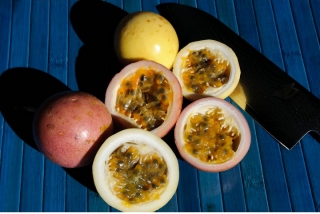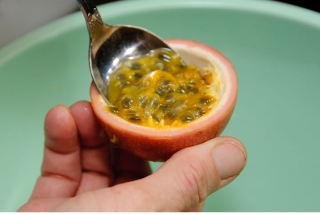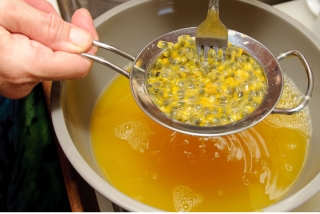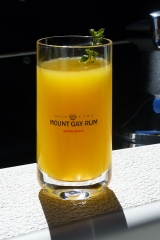Ann's Blog
Hog Island, Grenada:
January 22, 2011
Put some passion in your winter
I’m just back from spending a week with my 90-year-old dad in New Jersey (which is why there was no posting last week). Before I headed north, I did some shopping in downtown St. George’s so I could bring Dad a taste of Grenada. Dark chocolate from the Grenada Chocolate Company was a given. So too were cocoa balls for cocoa tea. But then I also headed to a little shop called Caribbean Naturals (part of the Grenada Craft Centre) to pick up some “bilimbi pickle.”
A friend had gifted me a jar of this hot-and-spicy condiment flavored with curry, peppers, and mustard seed, and I was pretty sure Dad would enjoy it. Its main ingredient, bilimbi (also called “one finger”), is a sour, acidic fruit that looks kind of like a smooth-skinned pickling cucumber. It doesn’t grow on a vine, however, but on a small tree – straight out of the trunk, in bunches. I’ve yet to see one growing, or find fresh ones for sale, but Caribbean Spice Island Plants (my indispensable guide to the island’s flora) contains a most intriguing fact about fresh bilimbi: If a small bit is eaten raw and immediately followed by a drink of water, “the sourness on the tongue changes to a sweetish sensation.” Wow. It sounds like a Caribbean version of the miracle fruit, and now I’ll be asking all the Grenadians I know for a source of raw bilimbi so I can give it a try.
Caribbean Spice Island Plants goes on to say, however, that usually the fruit is pickled, candied, or used in sauces. Dad and I both loved the bilimbi pickle, and we managed to polish off the whole jar during my visit.
I also brought him a jar of another Caribbean Naturals product, called “passion fruit honey.” When I questioned the owner, that turned out to be a bit of a misnomer, as bees had nothing to do with its creation. It’s an intensely concentrated syrup made from passion fruit, with an amazing floral aroma and a citrusy tart-sweet taste – but with a honeylike consistency. Dad and I enjoyed it instead of conventional honey in tea, and we puddled it on waffles.
Which got me thinking about buying passion fruit when I got back to the boat. They’re easy to come by at this time of year – a bag of 8 or 10 costing the equivalent of $1.75–$2.00. I love to make juice from them. Here’s what you do:
1. Cut 8 or 9 passion fruit in half. (Some people stop right here and spoon the pulp straight into their mouths. But for me, they have too many seeds to deal with when eaten this way.) Scoop the pulp into a bowl.
2. Mix with about 2 cups of water and stir with a fork. Allow to stand for at least a half hour, stirring vigorously every so often.
3. Strain through a sieve into a bottle or pitcher, pressing on the pulp and seeds to extract as much juice as possible.
5. Sweeten to taste with simple syrup or cane syrup.
Great straight, or use your juice to make a Passion Mojito. (Use my recipe for a Saga Boy Mojito, substituting your passion fruit juice for portugal or tangerine juice.)
This morning, I decided to give my own version of passion fruit honey a try. The first go was acceptable, but not perfect. I’ll let you know when (and if) I nail it.
Back to topSign up to be notified by email when I post a new blog





